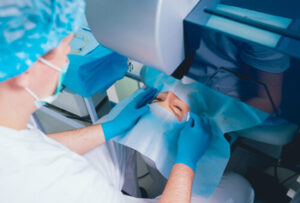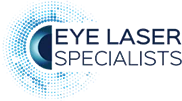Have you ever dreamt of ditching your glasses or contact lenses and waking up to clear, crisp vision every day? Laser eye surgery can make that dream a reality. This cutting-edge treatment has transformed the lives of millions of people by permanently correcting refractive errors, the most common vision problems affecting our ability to see clearly. But how effective is laser eye surgery anyway?
This article delves into the effectiveness of laser eye procedures, exploring their benefits, different types, what to expect during the procedures, and aftercare tips to minimise potential risks.
Seeing Double? Unveiling The Causes Of Blurred Vision And The Role Of Laser Eye Procedure
Our eyes direct light rays to the retina, a light-sensitive layer at the rear of your eye. When this focusing process goes awry due to the cornea’s shape (the eye’s clear outer dome), refractive errors occur. These errors result in blurry vision at various distances, leading to conditions like:
- Myopia (Short-Sightedness):
 Difficulty seeing distant objects clearly.
Difficulty seeing distant objects clearly. - Hyperopia (Long-Sightedness): Difficulty focusing on near objects.
- Astigmatism: Blurred or distorted vision no matter the distance due to an irregularly shaped cornea.
Laser eye surgery, also known as refractive laser surgery, utilises an excimer laser to reshape the corneal tissue, correcting the focusing power and ultimately improving vision. This minimally invasive treatment offers a permanent solution for many individuals who don’t want to wear glasses or contact lenses.
See The World In A New Light: Unwrapping The Benefits Of Laser Eye Surgery
Laser eye surgery has revolutionised vision correction, offering a life-changing experience for many. Here’s a deeper look at the multitude of benefits that can transform your daily life.
Improved Vision
The most significant advantage is undoubtedly the freedom from blurry vision. Laser eye surgery corrects refractive errors, allowing you to see the world in crisp detail, from the vibrant colours of a sunset to the intricate details on a loved one’s face. Imagine waking up every morning and being able to read the newspaper without reaching for glasses or finally appreciating the night sky without the hassle of contacts. This newfound clarity can significantly enhance your daily experiences and bring the world into sharper focus.
Convenience
Imagine a life free from the daily routines associated with corrective lenses. Laser eye surgery removes the need for constant cleaning of contact lenses or the frustration of misplaced glasses. No more scrambling to find your reading glasses before bed or worrying about losing or damaging your favourite pair during a workout. Laser eye surgery offers a sense of liberation and convenience that can streamline your mornings and simplify your daily activities.
Freedom In Activities
For those who enjoy an active lifestyle, laser eye surgery can be a game-changer. No more worrying about glasses slipping during a jog or the irritation of contacts while swimming. You can dive into your favourite sports and outdoor activities with confidence, experiencing the freedom of movement without the limitations of corrective lenses. This newfound freedom can open doors to new hobbies and a more active lifestyle.
Reduced Dependence On Corrective Lenses
While the initial investment in laser eye surgery may seem significant, it can translate to substantial cost savings in the long run. You’ll no longer need to factor in the ongoing expense of purchasing new glasses or contact lenses, along with their cleaning solutions. Over time, laser eye surgery can be a cost-effective solution, especially for individuals who have worn corrective lenses for many years.
Improved Self-Confidence
Many people experience improvements in their self-confidence after undergoing laser eye surgery. The ability to see clearly without relying on glasses can contribute to a more positive self-image. Without the physical barrier of glasses, you can experience a more natural way of interacting with the world and feel more confident in social settings.
From Blurry To Brilliant: How Soon Will You See Results After Laser Eye Surgery Procedure?
 Following laser eye treatment, most patients experience noticeable vision improvement within the first 24 to 48 hours. However, it typically takes a few weeks for your vision to fully stabilise. During this healing process, some patients may experience temporary fluctuations in vision, including blurriness or halos around lights. These are usually normal and subside as the cornea heals.
Following laser eye treatment, most patients experience noticeable vision improvement within the first 24 to 48 hours. However, it typically takes a few weeks for your vision to fully stabilise. During this healing process, some patients may experience temporary fluctuations in vision, including blurriness or halos around lights. These are usually normal and subside as the cornea heals.
Your eye doctor will provide specific guidelines regarding post-operative care to ensure optimal healing and minimise potential side effects.
Laser Vision Correction: Unveiling The Toolbox Of Refractive Surgery Techniques And Their Advantages
There are many types of laser eye surgeries, each with its own advantages and suitability for different types of refractive errors. Here’s a breakdown of the most common procedures:
LASIK Eye Surgery (Laser-Assisted In Situ Keratomileusis)
This is the most often done laser eye surgery. During LASIK surgery, a femtosecond laser forms a tiny flap in the cornea’s outer layers. The excimer laser then fixes the underlying corneal tissue, correcting the refractive defect. The flap is then replaced, and it heals spontaneously without the use of stitches. Individuals with mild to moderate myopia, hyperopia, and astigmatism benefit most from the LASIK procedure.
PRK (Photorefractive Keratectomy)
PRK is a well-established technique that uses the excimer laser directly to ablate (remove) corneal tissue and reshape the cornea. Unlike LASIK, PRK doesn’t create a corneal flap. PRK is often the gateway to restored vision for patients with thin corneas, as it avoids creating a flap that could weaken the cornea further.
Refractive Lens Exchange (RLE)
This procedure is an alternative to traditional laser eye surgery for those who are not suitable candidates for LASIK or PRK, often due to factors like age-related vision loss (presbyopia) or those with cataracts. Unlike other laser vision correction procedures that reshape the cornea, RLE involves replacing the natural crystalline lens inside your eye with an artificial intraocular lens (IOL). This IOL can be multifocal, allowing for clear vision at both near and far distances, eliminating the need for reading glasses. RLE offers a permanent solution for both refractive errors and cataracts.
SMILE (Small Incision Lenticule Extraction)
This is a relatively new and advanced laser eye surgery technique. SMILE utilises a femtosecond laser to create a lenticule, a small disc of corneal tissue, within the cornea. Then, a tiny incision is made, and the lenticule is removed through this incision, reshaping the cornea. SMILE offers several potential advantages, including less corneal tissue removal compared to LASIK and potentially faster healing times.
SMILE Pro
As an advancement of SMILE, SMILE Pro utilises the same basic principles but offers some potential improvements. SMILE Pro employs a more advanced femtosecond laser, which allows for faster and potentially more precise creation of the lenticule. This can translate to a shorter procedure time and potentially less impact on the surrounding corneal tissue. Additionally, SMILE Pro may offer a quicker visual recovery compared to SMILE. However, SMILE Pro is a newer technology and is only available at Eye Laser Specialists in Melbourne. It’s important to discuss both SMILE and SMILE Pro with your eye surgeon to determine which option is ideal for your individual needs and circumstances.
Under The Laser: A Patient’s Guide To The Laser Eye Surgery Experience
Laser eye surgery is mostly an outpatient procedure performed in a specialised surgical centre. Here’s a general overview of what to expect.
Pre-Operative Complimentary Consultation
You’ll undergo a comprehensive eye examination with your eye specialist to determine your candidature for laser eye surgery and discuss the most suitable procedure for your specific needs. This consultation will involve detailed discussions about your medical history and a thorough eye examination to evaluate the thickness and shape of your cornea.
The Procedure Itself
On the day of surgery, you’ll likely be given numbing eye drops to anaesthetise the area. Then, an excimer laser, which emits precise ultraviolet light pulses, reshapes the underlying corneal tissue to correct your refractive error. This process is computer-controlled and customised for your specific needs.
For LASIK procedures, a femtosecond laser creates a thin, precise flap in the outermost layer of your cornea. This flap acts like a lid, allowing access to the underlying corneal tissue. The corneal flap is then gently repositioned back into its original place. The natural properties of the cornea allow the flap to adhere without stitches.
Post-Operative Care
Following the procedure, your vision may be blurry or hazy for a short while. You’ll be provided with detailed instructions regarding post-operative care. Sticking to these instructions carefully is crucial to ensure an ideal recovery and minimise the risk of complications.
Pamper Your Peepers: Essential Post-Op Care For Laser Eye Surgery Success
The crucial part comes after leaping to clearer vision with laser eye surgery: ensuring optimal healing and achieving the fantastic vision you desire. Here’s your essential guide to pampering your peepers during the post-operative period:
Hydration Is Key
Your eye doctor will likely prescribe a combination of medicated eye drops, including antibiotics and anti-inflammatory medications. These drops are vital for reducing the risk of infection and promoting healing. Be meticulous with your application, following the prescribed dosage and frequency exactly. Don’t hesitate to set reminders if needed.
Staying well-hydrated supports your overall healing process. Drink plenty of water throughout the day to keep your body functioning optimally.
Minimise Screen Time
You may experience some light sensitivity after surgery. So step away from the screens! Excessive use of phones, computers, and televisions can strain your eyes during this sensitive healing period. Allow your eyes ample time to rest and recover. Implement screen-free breaks throughout the day, and consider using apps with night-time filters to reduce blue light exposure in the evenings.
Sunglasses Are Your Saviour
Wear sunglasses that block UVA and UVB rays outdoors, even on cloudy days. This will help protect your eyes from the sun’s glare and promote comfort.
Avoid Dusty Environments
Dust particles can irritate your eyes and increase the risk of infection. Remain indoors on days with high pollen counts or heavy dust storms. If you must go outside, wear protective eyewear, like wraparound sunglasses, for added protection.
Hands Off!
This might be the hardest part! Resist the urge to rub your eyes. Rubbing can dislodge the corneal flap (in LASIK procedures) and disrupt the healing process. If you feel an itch, use artificial tears or gently dab your eye with the corner of a clean, lint-free tissue.
No Swimming (For A While)
Hold off on diving into pools, lakes, or hot tubs for a specific period determined by your eye doctor. These environments harbour bacteria that can increase your risk of infection.
Washing Your Hair
Be extra cautious when washing your hair. Use a gentle shampoo and tilt your head back to avoid getting soap or shampoo in your eyes.
Rest And Recovery
Prioritise getting enough sleep during the first few days after surgery. Your body needs ample rest to facilitate healing.
Listen To Your Eyes
Pay attention to how your eyes feel. If you experience any unusual discomfort, excessive watering, or vision changes, don’t hesitate to contact your eye doctor immediately.
Schedule Adherence
Regular follow-up sessions with your eye specialist are essential. These checkups let your doctor monitor your healing process, handle any issues, and ensure everything is for optimal vision correction.
Frequently Asked Questions
Am I eligible for laser eye surgery?
The kind and severity of your refractive defect, corneal thickness, and overall eye health all influence whether you are a good candidate for laser eye surgery. Your eligibility will be evaluated with your eye specialist during a thorough eye examination.
Is laser eye surgery safe?
 Laser eye surgery is considered a pretty safe and well-established procedure. However, like any medical procedure, it carries potential risks, which will be discussed thoroughly with your eye surgeon during your consultation.
Laser eye surgery is considered a pretty safe and well-established procedure. However, like any medical procedure, it carries potential risks, which will be discussed thoroughly with your eye surgeon during your consultation.
How long does the procedure take?
Laser surgery is typically a quick procedure, lasting up to 30 minutes per eye. However, the entire process may take longer, including preparation and post-operative checks.
How much does laser eye surgery cost?
The cost of laser eye surgery can change significantly based on the type of procedure performed, your geographic location, and the surgeon’s experience. It’s advisable to consult a qualified eye surgeon to discuss their fees and what’s included in the cost.
Your Journey To Freedom From Glasses Starts Here
Laser eye surgery offers a life-changing gateway for many who no longer want to wear contact lenses or glasses. With its high success rates, improved vision technology, and a range of procedure options, laser eye surgery can significantly improve your overall quality of life and visual acuity. However, it’s important to remember that laser eye surgery is an elective procedure. Carefully consider your individual needs, discuss all options thoroughly with your eye doctor, and choose an appropriately qualified health practitioner with extensive experience in performing laser eye surgery.
By making an informed decision and following proper pre- and post-operative care, laser eye surgery can be a safe and efficient way to achieve the clear, sharp vision and enjoy a life less reliant on corrective lenses.
Contact Eye Laser Specialists, Armadale, VIC 3143, at (03) 9070 5788 to enjoy life with corrected vision without resorting to glasses or contact lenses.
Note: Any surgical or invasive procedure carries risks. Before proceeding, you should seek a second opinion from an appropriately qualified health practitioner.
Sources:
Bowen, D. W. “Blurred Vision: Cause?” Gut, vol. 55, no. 2, Feb. 2006, p. 211. https://doi.org/10.1136/gut.2005.068833.
Chiche, Anthony, et al. “Early Recovery of Quality of Vision and Optical Performance After Refractive Surgery: Small-incision Lenticule Extraction Versus Laser in Situ Keratomileusis.” Journal of Cataract & Refractive Surgery/Journal of Cataract and Refractive Surgery, vol. 44, no. 9, Sept. 2018, pp. 1073–79. https://doi.org/10.1016/j.jcrs.2018.06.044.
“LASIK Eye Surgery.” WebMD, 9 Nov. 2022, www.webmd.com/eye-health/lasik-laser-eye-surgery.
Moshirfar, Majid, et al. “Small Incision Lenticule Extraction.” StatPearls – NCBI Bookshelf, 26 Feb. 2024, www.ncbi.nlm.nih.gov/books/NBK549896.
Nhs. “Laser Eye Surgery and Lens Surgery.” nhs.uk, 16 Feb. 2024, www.nhs.uk/conditions/laser-eye-surgery-and-lens-surgery.
Noda-Tsuruya, Tomoko, MD PhD. “Autologous Serum Eye Drops for Dry Eye After LASIK | Journal of Refractive Surgery.” Journal of Refractive Surgery, journals.healio.com/doi/10.3928/1081-597X-20060101-13.
Professional, Cleveland Clinic Medical. “Photorefractive Keratectomy (PRK) Eye Surgery.” Cleveland Clinic, my.clevelandclinic.org/health/treatments/8596-photorefractive-keratectomy-prk-eye-surgery.
Research, Center for Biologics Evaluation And. “What Should I Expect Before, During, and After Surgery?” U.S. Food And Drug Administration, 11 July 2018, www.fda.gov/medical-devices/lasik/what-should-i-expect-during-and-after-surgery.
Saad, Amr, et al. “Refractive Outcomes of Small Lenticule Extraction (SMILE) Pro® With a 2 MHz Femtosecond Laser.” International Ophtalmology/International Ophthalmology, vol. 44, no. 1, Feb. 2024, https://doi.org/10.1007/s10792-024-02915-2.
Sakimoto, Tohru, et al. “Laser eye surgery for refractive errors.” Lancet, vol. 367, no. 9520, Apr. 2006, pp. 1432–47. https://doi.org/10.1016/s0140-6736(06)68275-5.




